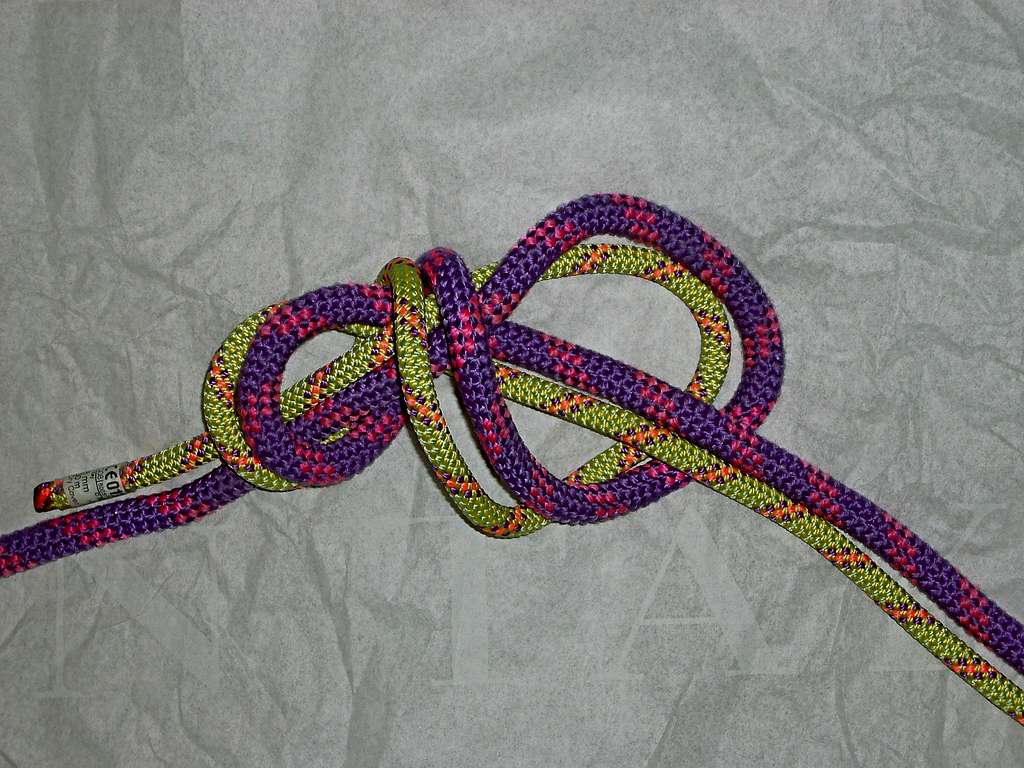Yet another knot to join two ropes for rappel
|
|
I know there's a deeply entrenched idea that if something works, why change it? In the case of the EDK, yes, I've personally used it for more than a decade without killing myself, and I know how to mitigate the danger of it "rolling" or "capsizing". But I also don't believe that we've already perfected every technique in climbing, and we can't find a new and improved way of doing things anymore. Lately, I've been playing with tying a single fisherman's knot (barrel knot, strangle knot, double overhand... however you call it) with both strands of rope. It has the same flat profile of the EDK, and it's a little easier to tie than the flat double fisherman's knot. I don't have any means to pull-test this knot, the best I can do is to leave it loosely tied and imagine what can happen with it when pulled. In the process of manipulating the knot, I got it to "roll" once by hand, but the resulting new knot does not seem like it can roll. You can basically tie this new knot by making two spiral loops toward the tail of the rope, bring the tail down first, then up through the two spiral loops. I'm sure there's a name for this knot, but I don't know what it is. I've been hesitant to post this on MP because I can imagine what the responses will be (ye gonna die!), but the "alpine butterfly bend" thread and the fairly civil discussion inspired me to post this new knot. Is there anyone with the means and the desire to pull-test this? |
|
|
Looks ok. I'm gonna test this on my climbing wall tomorrow and will let you know ... unless there are 47 other posts by then telling you your gonna die... |
|
|
another advantage of the EDK is that it is fairly easy to untie, how do these knots compare? |
|
|
keithconn wrote:Looks ok. I'm gonna test this on my climbing wall tomorrow and will let you know ... unless there are 47 other posts by then telling you your gonna die...Test close to the ground, or ye gonna die! Just kidding... Rui Ferreira wrote:another advantage of the EDK is that it is fairly easy to untie, how do these knots compare?I've bounce tested the new knot (the last one pictured) many times in my garage, it has always been easy to untie afterwards. The two strands going over everything else from top to bottom (the very loose strands in my photo) can be used to "peel" the knot back easily. It's as easy to untie as the EDK, and much easier than the traditional double fisherman's and the flat double fisherman's. |
|
|
Same as this ? This knot is recommended for joining ropes of very different diameters in instructional material of the National Council of Italian Mountain Guides that was published in 2003. If memory serves, it was tested by CAI and didn't roll. |
|
|
brenta wrote:Same as this ? This knot is recommended for joining ropes of very different diameters in instructional material of the National Council of Italian Mountain Guides that was published in 2003. If memory serves, it was tested by CAI and didn't roll.Thank you! This is exactly the knot I tied in my second photo. Do you happen to have that instructional material you mentioned? I was trying to see if this knot can roll or not by leaving it tied very loosely and move stuff around by hand. In the photo you posted below, by flipping the yellow and purple loops on the right all the way to the left, I got the knot in my third photo. t.farrell wrote:Double Fish - If red strand gets weighted, it could slip out then you're left with the 1/2 fisherman's with a stopper? Just feel like it's introducing more possibilities of failures.Actually, people have already come up with possible (but improbable IMO) failure modes for the flat double fisherman's knot. I'm only posting this knot to show how I arrived at the new knot. t.farrell wrote:Double Overhand - Wouldn't this roll more easily since the knot can't cinch down as tightly overhand? Or am I overthinking it? Also, new knot is still a double overhand tied differently. You'd tie it that way if you wanted to make a strangle knot which is a double overhand around an object.The second knot in my original post is the strangle knot, the second and the third are tied differently, but you're probably right, the third knot may just be a variation of the double overhand, since you can get the third knot by flipping two loops in the second knot. In any case, you should try the double overhand and see if it will roll. Once you get the bottom loop flipped over to the top (going from my second photo to the third), you can't get the knot to roll any further without pulling the tail through. |
|
|
Same same? rockandice.com/climbing-gea… |
|
|
t.farrell wrote: I'll try to find a way to explain it. They're they same knot tied different ways/dressed different ways.I agree with you for the second time. The real question is, does the double overhand knot roll when pulled? Michael Scott wrote:Same same? rockandice.com/climbing-gea…Hmmm... that's different from how I tied it, but the end result is the same. |
|
|
As already mentioned, the big flat fish has a failure mode. |

 Continue with onX Maps
Continue with onX Maps Continue with Facebook
Continue with Facebook























